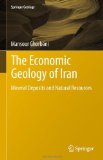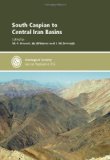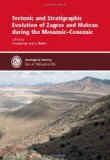Geology of Iran
- Geological Survey of Iran
- 2D basin modeling study of the Binak Trough, northwestern Persian Gulf, Iran

- A metallogenetic model for carbonate-hosted non-sulphide zinc deposits based on observations of Mehdi Abad and Irankuh, Central and Southwestern Iran

- A Paleogene extensional arc flare-up in Iran

- An active fault zone in the Western Kopeh Dagh (Iran)

- Barremian - Lower Albian sequence-stratigraphy of southwest Iran (Gadvan, Dariyan and Kazhdumi formations) and its comparison with Oman, Qatar and the United Arab Emirates

- Biostratigraphy and Sequence Stratigraphy of Paleogene Deposits in Central Kopet-Dagh Basin (NE of Iran)

- Building the Zagros collisional orogen: timing, strain distribution and the dynamics of Arabia/Eurasia plate convergence

- Calcite twinning constraints on late Neogene stress patterns and deformation mechanisms in the active Zagros collision belt

- Carbon-isotope stratigraphy, biostratigraphy and organic matter distribution in the Aptian – Lower Albian successions of southwest Iran (Dariyan and Kazhdumi formations)

- Challenges in deep basin sequence stratigraphy: A case study from the Early-Middle Cretaceous of SW Zagros

- Chemistry of magmatic and alteration minerals in the Chahfiruzeh porphyry copper deposit, south Iran: implications for the evolution of the magmas and physicochemical conditions of the ore fluids

- Chemo-stratigraphy as a tool for sequence stratigraphy of the Early Triassic Kangan Formation, North of the Persian Gulf

- Controls on depositional facies in Upper Cretaceous carbonate reservoirs in the Zagros area and the Persian Gulf, Iran

- Controls on Reservoir Quality in the Early Triassic Kangan Formation, Iran

- Dehshir ophiolite (central Iran): Geochemical constraints on the origin and evolution of the Inner Zagros Ophiolite Belt

- Depositional environment and sequence stratigraphy of the Upper Cretaceous Ilam Formation in central and southern parts of the Dezful Embayment, SW Iran

- Depositional sequences, diagenesis and structural control of the Albian to Turonian carbonate platform systems in coastal Fars (SW Iran)

- Early Cretaceous Calcareous Benthic Microfossils From The Eastern Alborz and Western Kopet Dagh (Northern Iran) and Their Stratigraphic Significance

- Early Oligocene Larger Foraminiferal Biostratigraphy of the Qom Formation, South of Uromieh (NW Iran)

- Echinoids and pectinid bivalves from the Early Miocene Mishan Formation of Iran

- Eo-Cimmerian (Late? Triassic) orogeny in North Iran

- Evidence for pre-folding vein development in the Oligo-Miocene Asmari Formation in the Central Zagros Fold Belt, Iran

- Evidence for Quaternary activity along the Deshir Fault: implication for the Tertiary tectonics of Central Iran

- Facies analysis and sequence stratigraphy of the Asmari Formation in the northern area of Dezful Embayment, south-west Iran

- Fracture patterns in the Zagros Simply Folded Belt (Fars): New constraints on early collisional tectonic history and role of basement faults

- Geochemical evidence for deep mantle melting and lithospheric delamination as the origin of the inland Damavand volcanic rocks or northern Iran

- Geochemical signature of Eocene Kuh-e Dom shoshonitic dikes in NE Ardestan, Central Iran: implications for melt evolution and tectonic setting

- Geochemistry of microgranular enclaves in Aligoodarz Jurassic arc pluton, western Iran: implications for enclave generation by rapid crystallization of cogenetic granitoid magma

- Geodynamic evolution of late Cretaceous Zagros ophiolites: Formation of Oceanic Lithosphere above a Nascent Subduction Zone

- Geology, petrology and geochemical characteristics of alteration zones within the Seridune prospect, Kerman, Iran

- Geology of Damavand volcano, Alborz Mountains, northern Iran

- Geology of the High Zagros (Iran) Tectonic and Thermal Evolution during the Paleozoic

- Iranian Geology Blog
- Late Cenozoic and modern stress fields in the western Fars (Iran): implications for the tectonic and kinematic evolution of Central Zagros

- Late Cretaceous Fore-arc ophiolites of Iran

- Lithostratigraphy and biostratigraphy of Oligocene Miocene deposits (Asmari Formation) in south-west Iran (Zagros basin, northern Khorramabad)

- Lithostratigraphy and biostratigraphy of the Lower Cretaceous of the Jalmajird area (northeast of Khomeyn, Central Iran Basin), Iran

- Lower Eocene transgressive successions of Sahlabad province, eastern Iran, implication of biostratigraphy and microfacies analysis

- Magmatic differentiation in the calc-alkaline Khalkhab–Neshveh pluton, Central Iran

- Metamorphic history and geodynamic significance of the Early Cretaceous Sabzevar granulites (Sabzevar structural zone, NE Iran)

- Microfacies and palaeoenvironments of the Lower Carboniferous Mobarak Formation in the Kiyasar section, Northern Iran

- Microfacies correlation analysis of the Oligocene-Miocene Asmari Formation, in the central part of the Rag-e-Safid anticlinal oil field, Zagros Basin, south-west Iran

- Microseismicity and seismotectonics of the South Caspian Lowlands, NE Iran

- New Findings Of Permian Marine And Terrestrial Fossils In Central Iran (the Kalmard Block) And Their Significance For Correlation Of The Tethyan, Uralian, And West European Scales

- Oligo-/Miocene Qom Formation (Iran) : evidence for an early Burdigalian restriction of the Tethyan seaway and closure of its Iranian gateway

- Palynology and isotope geochronology of the Upper Ordovician-Silurian successions (Ghelli and Soltan Maidan Formations) in the Khoshyeilagh area, eastern Alborz Range, northern Iran

- Pennsylvanian Stratigraphy and Fusulinids of Central and Eastern Iran

- Petrogenesis of Quaternary Shoshonitic Volcanism in NE Iran (Ardabil): Implication for Postcollisional Magmatism

- Petrography, geochemistry and geodynamic environment of potassic alkaline rocks in Eslamy peninsula, northwest of Iran

- Petroleum Geology and Resources of the Amu-Darya Basin, Turkmenistan, Uzbekistan, Afghanistan, and Iran

- Regional stratigraphic architecture and reservoir types of the Oligo-Miocene deposits in the Dezful Embayment (Asmari and Pabdeh Formations) SW Iran

- Salt Plugs in the Eastern Zagros, Iran: Results of Regional Geological Reconnaissance

- Sedimentary environment and palaeogeography of the ?Palaeocene-Middle Eocene Kashkan Formation, Zagros fold-thrust belt, SW Iran
- Stegocornu and associated brachiopods from the Silurian (Llandovery) of Central Iran

- Stratigraphy, ichnology, and sedimentary environments of the Late Bajocian-Late Bathonian Kashafrud Formation, Northeastern Iran

- Subduction-related Eocene shoshonites from the Cenozoic Urumieh-Dokhrat magmatic arc (Qaleh-Khargooshi area, West of the Yazd province, Iran)

- Tertiary of the Arabian Gulf: sedimentology and hydrocarbon potential

- Tertiary sequence of deformation in a thin-skinned/thick-skinned collision belt: the Zagros Folded Belt (Fars, Iran)

- U-Pb age, geochemistry and tectonic significance of granitoids in the Soursat Complex, Northwest Iran

- Zagros Core: Deformation of the continental lithospheric mantle

- Zagros Folded Belt (Fars, Iran): constraints from topography and critical wedge modelling

Books about geology of Iran
The Economic Geology of Iran: Mineral Deposits and Natural Resources |
|
| South Caspian to Central Iran Basins This book combines interdisciplinary research results using structural geology, geophysics, sedimentology, stratigraphy, palaeontology, palaeomagnetism and subsidence modelling obtained through the MEBE (Middle East Basins Evolution) Programme and other groups in the South Caspian and Northern and Central Iran. A great part of the volume is devoted to Northern Iran (Alborz, Binalud and Koppeh Dagh belts), dealing mainly with the Late Palaeozoic and the Mesozoic Eras. Two papers present subsidence models of the South Caspian Basin since the Jurassic and three papers focus on Central Iran. The data and models in this compilation of papers present a detailed picture and a very comprehensive understanding of the Late Palaeozoic to Cenozoic evolution of the South Caspian and North Iran to Central Iran basins. Geodynamic evolution and sedimentation are mainly controlled by the closure of the Palaeo-Tethys due to collision of Eocimmerian blocks with south Laurasia, opening of the South Caspian Basin, and Neo-Tethys ocean closure associated with Arabia-Eurasia collision. |
|
| Tectonic and Stratigraphic Evolution of Zagros and Makran during the Mesozoic-Cenozoic The Zagros fold-thrust belt (ZFTB) extends from Turkey to the Hormuz Strait, resulting from the collision of the Arabian and Eurasian plates during Cenozoic times, and separates the Arabian platform from the large plateaux of central Iran. To the east a pronounced syntaxis marks the transition between the Zagros collision belt and the Makran accretionary wedge. In the ZFTB, the Proterozoic to Recent stratigraphic succession pile is involved in huge folds, and offers the opportunity to study the stratigraphic and tectonic evolution of the Palaeo-Tethyan margin. Few recent data were widely available on the southern Tethys margin preserved in the Zagros Mountains. The Middle East Basins Evolution (MEBE) program was an excellent opportunity to go back to the field and to collect new data to better constrain the evolution of this margin. In this volume the structure of the Zagros Mountains is explored through different scales and using different methodologies. |


